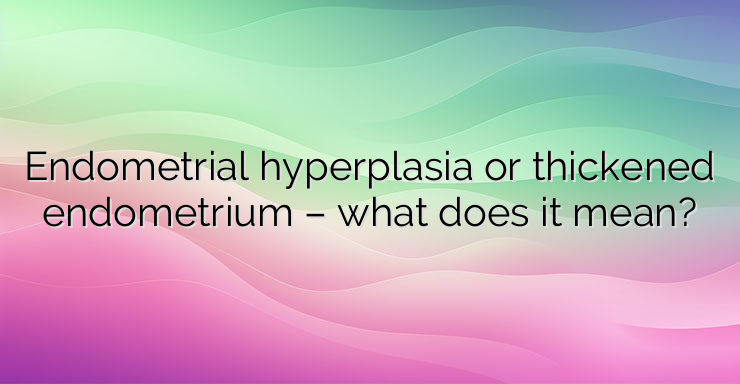Endometrial hyperplasia thickens the lining of the uterus, causing heavy or unusual bleeding. Atypical endometrial hyperplasia increases the risk of endometrial and uterine cancer. The condition usually occurs during or after menopause. The endometrium is the lining that is shed during the menstrual cycle. This is also the tissue in which the amniotic sac grows during pregnancy. In some women, endometrial hyperplasia can lead to endometrial cancer. Specialists classify endometrial hyperplasia based on the types of cellular changes in the lining of the endometrium. Some types of endometrial hyperplasia significantly increase the risk of cancer, while others do not. Types of endometrial hyperplasia include: Simple or complex endometrial hyperplasia without atopy. This type of endometrial hyperplasia has normal-looking cells that are unlikely to become cancerous. This condition may improve without specific treatment. Simple or complex atypical endometrial hyperplasia with atopy. If the type of endometrial hyperplasia is “atopic” it has a greater chance of turning into cancer. Without treatment, the risk of endometrial or uterine cancer increases significantly. Women with endometrial hyperplasia complain of: Abnormal menstrual bleeding or bleeding between periods; Short menstrual cycles (lasting less than 21 days); Heavy menstrual bleeding; Bleeding after menopause; Absence of periods at all (amenorrhea). Many of these symptoms are common in women going through menopause. The transition to menopause often means irregular or missed periods and irregular bleeding. What are the most common causes of endometrial hyperplasia? The body of women with endometrial hyperplasia produces too much estrogen and not enough progesterone. These hormones play an essential role in menstruation and pregnancy. During ovulation, estrogen thickens the endometrium, while progesterone prepares the uterus for pregnancy. If conception does not occur, progesterone levels drop. The drop in progesterone triggers the shedding of the lining during the menstrual cycle. Women diagnosed with endometrial hyperplasia produce little, if any, progesterone. As a result, the uterus does not secrete the lining of the endometrium. Instead, the lining continues to grow and thicken. The cells that make up the lining can grow close together and become irregular. All types of hyperplasia can cause abnormal and heavy bleeding, which can lead to the development of anemia. Untreated atypical endometrial hyperplasia can become cancerous. Endometrial or uterine cancer develops in about 8% of women with untreated simple atopic endometrial hyperplasia. Nearly 30% of patients with complex atopic endometrial hyperplasia who do not receive treatment develop cancer. References: 1. American Academy of Family Physicians. Endometrial Hyperplasia. (https://familydoctor.org/condition/endometrial-hyperplasia/) 2. American Cancer Society. Endometrial Cancer Risk Factors. (https://www.cancer.org/cancer/endometrial-cancer/causes-risks-prevention/risk-factors.html) 3. American College of Obstetricians and Gynecologists (ACOG). Endometrial Hyperplasia. (https://www.acog.org/womens-health/faqs/endometrial-hyperplasia) 4. Singh G, Puckett Y. Endometrial Hyperplasia. (https://www.ncbi.nlm.nih.gov/books/NBK560693/) 2022 Jul 19. In: StatPearls [Internet]. Treasure Island, FL: StatPearls Publishing; 2022 Jan-. 5. US National Cancer Institute. Endometrial Hyperplasia. (https://www.cancer.gov/publications/dictionaries/cancer-terms/def/endometrial-hyperplasia)


Leave a Reply